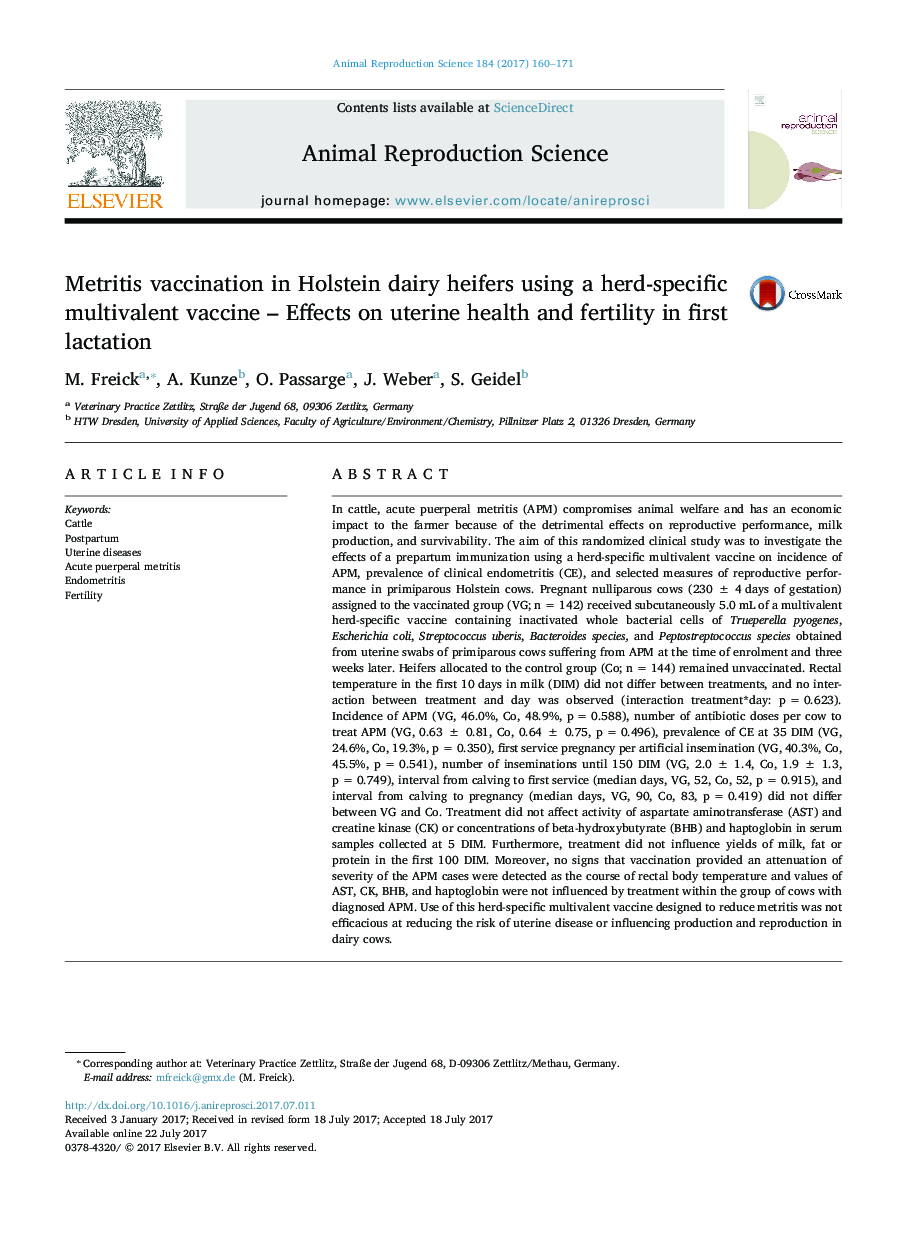| کد مقاله | کد نشریه | سال انتشار | مقاله انگلیسی | نسخه تمام متن |
|---|---|---|---|---|
| 5520239 | 1544693 | 2017 | 12 صفحه PDF | دانلود رایگان |

- Vaccination might be a useful tool to prevent acute puerperal metritis (APM) in dairy cows (Machado et al., 2014).
- Effects of a multivalent herd-specific metritis vaccine in primiparous dairy cows were investigated.
- The vaccine was not efficacious at reducing the risk of uterine diseases or influencing production and reproduction.
- Inadequate immune response or non-suitability of the vaccination design to prevent APM are possible reasons for failure.
In cattle, acute puerperal metritis (APM) compromises animal welfare and has an economic impact to the farmer because of the detrimental effects on reproductive performance, milk production, and survivability. The aim of this randomized clinical study was to investigate the effects of a prepartum immunization using a herd-specific multivalent vaccine on incidence of APM, prevalence of clinical endometritis (CE), and selected measures of reproductive performance in primiparous Holstein cows. Pregnant nulliparous cows (230 ± 4 days of gestation) assigned to the vaccinated group (VG; n = 142) received subcutaneously 5.0 mL of a multivalent herd-specific vaccine containing inactivated whole bacterial cells of Trueperella pyogenes, Escherichia coli, Streptococcus uberis, Bacteroides species, and Peptostreptococcus species obtained from uterine swabs of primiparous cows suffering from APM at the time of enrolment and three weeks later. Heifers allocated to the control group (Co; n = 144) remained unvaccinated. Rectal temperature in the first 10 days in milk (DIM) did not differ between treatments, and no interaction between treatment and day was observed (interaction treatment*day: p = 0.623). Incidence of APM (VG, 46.0%, Co, 48.9%, p = 0.588), number of antibiotic doses per cow to treat APM (VG, 0.63 ± 0.81, Co, 0.64 ± 0.75, p = 0.496), prevalence of CE at 35 DIM (VG, 24.6%, Co, 19.3%, p = 0.350), first service pregnancy per artificial insemination (VG, 40.3%, Co, 45.5%, p = 0.541), number of inseminations until 150 DIM (VG, 2.0 ± 1.4, Co, 1.9 ± 1.3, p = 0.749), interval from calving to first service (median days, VG, 52, Co, 52, p = 0.915), and interval from calving to pregnancy (median days, VG, 90, Co, 83, p = 0.419) did not differ between VG and Co. Treatment did not affect activity of aspartate aminotransferase (AST) and creatine kinase (CK) or concentrations of beta-hydroxybutyrate (BHB) and haptoglobin in serum samples collected at 5 DIM. Furthermore, treatment did not influence yields of milk, fat or protein in the first 100 DIM. Moreover, no signs that vaccination provided an attenuation of severity of the APM cases were detected as the course of rectal body temperature and values of AST, CK, BHB, and haptoglobin were not influenced by treatment within the group of cows with diagnosed APM. Use of this herd-specific multivalent vaccine designed to reduce metritis was not efficacious at reducing the risk of uterine disease or influencing production and reproduction in dairy cows.
Journal: Animal Reproduction Science - Volume 184, September 2017, Pages 160-171